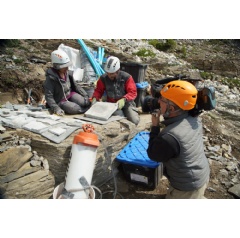ROM’s fieldwork expedition to the Burgess Shale documented in CBC TV’s The Nature of Things episode First Animals
Five hundred million years ago the first animals on our planet lived in the oceans. Fast forward to today and watch ROM scientists uncover those evolutionary wonders from Canada’s famous Burgess Shale in the new documentary First Animals, premiering on The Nature of Things, Friday, October 25 at 9 p.m. on CBC and CBC Gem.
First Animals follows the fascinating work of Dr. Jean-Bernard Caron, the ROM’s Richard M. Ivey Curator of Invertebrate Palaeontology, and his team as they make remarkable discoveries in the Rocky Mountains of Kootenay National Park, including the thrilling discovery of a new species, Cambroraster falcatus.
“The Burgess Shale fossils are incredibly important to science and have been ever since they were first discovered in 1909,” says Caron. “It’s imperative for us to share with Canadians these discoveries, which tell us so much about the evolution of early animal life, including the group of animals we belong to—the vertebrates.”
First Animals is hosted by Dr. Maydianne Andrade, an evolutionary biologist at the University of Toronto. In the episode, Andrade is on hand to watch as the rocks are split open and early Cambrian animals are revealed. “These fossils represent the beginning of all animal life, which kick-started evolution and a half-billion-year-old family tree that includes us" she says.
Produced by Red Trillium Films, the documentary takes viewers from the Cambrian fossils high in the Rocky Mountains to Newfoundland’s Mistaken Point where researchers examine enigmatic 565-million-year-old Precambrian, Ediacaran Period, fossils of large multicellular creatures at the edge of the ocean.
The documentary traces how researchers decipher these fossils and create drawings and 3D animation to digitally restore the flat, grey fossil specimens into visually dynamic creatures that move, swim and hunt. Viewers even see researchers conduct hydrodynamic tests on a model of one of the oldest vertebrates known, the primitive fish Metaspriggina, to learn how it might have swum.
“I don’t think most Canadians realize how rich this country is in fossil evidence of the earliest forms of life,” says writer-director Andrew Gregg. “We have more to discover here than anywhere else. To be on hand when the rocks are split open, and to see animals that lived here over 500 million years ago, it really makes you appreciate the evolutionary process that brought us to where we are today.”
Recently discovered species, like Cambroraster falcatus, and other animal species featured in the documentary, will be among the many new exceptional fossils from the Burgess Shale to go on display in the ROM’s upcoming new 10,000-square-foot gallery, the Willner Madge Gallery, Dawn of Life. Set to open in 2021, the gallery will tell the remarkable history of life on Earth from the earliest evidence of life up to the age of dinosaurs. Canada’s rich palaeontological record will be showcased with specimens from Canadian UNESCO World Heritage Sites including Joggins Fossil Cliffs (Nova Scotia), Mistaken Point (Newfoundland and Labrador) and Miguasha National Park (Quebec), in addition to the Burgess Shale in Yoho and Kootenay National Parks (British Columbia).
( Press Release Image: https://photos.webwire.com/prmedia/6/248597/248597-1.jpg )
WebWireID248597
This news content was configured by WebWire editorial staff. Linking is permitted.
News Release Distribution and Press Release Distribution Services Provided by WebWire.
